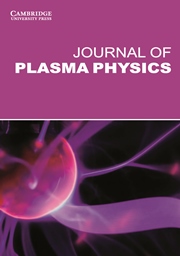Crossref Citations
This article has been cited by the following publications. This list is generated based on data provided by
Crossref.
Sreeraj, T.
Singh, S. V.
and
Lakhina, G. S.
2016.
Coupling of electrostatic ion cyclotron and ion acoustic waves in the solar wind.
Physics of Plasmas,
Vol. 23,
Issue. 8,
Kumar, Sarvesh
Sharma, Jyotsna
Sharma, Prashant
Sharma, Shatendra
Mathur, Yaduvansh
Sharma, Devendra
and
Kashyap, Manish K.
2018.
Experimental investigation of plasma instabilities by Fourier analysis in an electron cyclotron resonance ion source.
Physical Review Accelerators and Beams,
Vol. 21,
Issue. 9,
Sreeraj, T
Singh, S V
and
Lakhina, G S
2019.
Higher harmonic instability of electrostatic ion cyclotron waves.
Pramana,
Vol. 92,
Issue. 5,
Sharma, Jyotsna
and
Sharma, Suresh C.
2022.
Neutral beam driven ion cyclotron instability of lower hybrid wave in a tokamak plasma.
AIP Advances,
Vol. 12,
Issue. 8,
Kumar, Amit
Dhawan, Rajat
Gupta, Ruby
and
Sharma, Jyotsna
2022.
Generation of ion cyclotron instability by parametric coupling of gyrating ion beam with lower hybrid wave in a complex plasma.
Materials Today: Proceedings,
Vol. 62,
Issue. ,
p.
3263.
Kumar, Amit
Gupta, Ruby
and
Sharma, Jyotsna
2022.
Electromagnetic Weibel instability in spatial anisotropic electron–ion plasmas.
AIP Advances,
Vol. 12,
Issue. 6,
Kumar, Amit
Yadav, Meena
Gupta, Ruby
and
Sharma, Jyotsna
2023.
Temperature anisotropy driven Weibel instability in carbon plasma.
Vol. 2814,
Issue. ,
p.
030004.
Sharma, Jyotsna
Singh, Siddhartha
Kumar, Amit
Hossain, Md. Amzad
Ahammad, Shaik Hasane
and
Rashed, Ahmed Nabih Zaki
2023.
Study of the Shear Alfvén Waves via Parametric Degeneration of Lower Hybrid Pump Wave in Dusty Plasma.
Brazilian Journal of Physics,
Vol. 53,
Issue. 5,
Kumar, Amit
and
Sharma, Jyotsna
2023.
Gyrating ion beam driven dust acoustic wave instability in a complex plasma.
Vol. 2821,
Issue. ,
p.
060004.
Rozina, Ch.
Pervaiz, Maryam
Iqbal, Zafar
and
Nadeem, Nourina
2023.
Specific features of electromagnetic waves in degenerate two stream electron-ion plasma: self-induced magnetic field.
Zeitschrift für Naturforschung A,
Vol. 78,
Issue. 9,
p.
783.
Pahuja, Twinkle
Kumar, Amit
Sagar, Himank
Gupta, Ruby
and
Sharma, Jyotsna
2024.
Impact of external magnetic field on temperature anisotropy driven Weibel instability in a magnetized plasma.
AIP Advances,
Vol. 14,
Issue. 2,

